There are hundreds of case studies built to highlight social media’s strength as a traffic generation platform. There are hundreds more explaining its ability to increase participation and inspire users to complete specific actions. What the industry is missing is an authoritative case study on one of the most important success metrics out there: its value for sales-driven businesses.
Sure, there are pieces of information out there, maybe even a rough outline or two. What’s missing isn’t the potential for optimized sales results to happen – any social media marketer knows how worthwhile the medium is as a sales tool – but a scientific look at the improvements that can help it increase the bottom line of small, independent, everyday businesses.

These two tips can help you do just that, whether for your own independent operation or as part of a larger organization. Don’t worry – none require technical wizardry or complex coding skills – just a basic understanding of social media and enough time to carry out some basic A/B or split testing.
1) Exclude more people from your community.
At its heart, social media is about community. Seth Godin highlighted the value of a leader-guided online community in Tribes, explaining that a dedicated and enthusiastic online group can create more than the sum of its parts with the right leadership. But that group can’t succeed without a goal that’s shared, and sometimes creating that common goal requires eliminating some members.
Don’t fence off your group after you’ve spent years building it – instead, set up some light rules for participation before you make it public. Excluding people based on their membership or customer status may not seem particularly social, but it can lead to a community experience that’s often lost on larger social networking groups and open forums.
2) Add sales-driven elements to all of your social media presences, and start testing.
For marketers, social media is about both community and commerce. There’s no value in an online community lacking any commercial intent, just as there’s little value in web traffic that simply isn’t interested in buying. Adding sales-driven elements into your social media pages may scare away a collection of uninterested users, but it comes with a surge in the proportion of sales-friendly users.
By guiding your users through sales-driven actions, collecting data, and generating test sales, you can quickly and easily grow to understand the commercial makeup of your audience. Some users may be the buying type, interested in quick results and guided success, while others may show an interest in products, services, and offers that you previously never expected to discover.
Jeannine Grich, CVA, MVA, EthicsChecked™, provides marketing and social media support, training and consulting to busy entrepreneurs. For information about finding a VA, download her FREE 10-Step Guide to Finding the Right VA, or to learn why Social Media should be an important part of your marketing plan with her FREE Report, Social Media Marketing Benefits, visit: https://accbizsvc.com, or contact her at Jeannine@accbizsvc.com